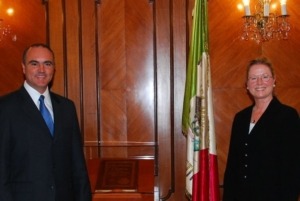Guest Blogger: Pati Ruiz Corzo
The good news of the international validation of Sierra Gorda´s Premium Carbon product filled us with pleasure since we have been working on this for many years and have experienced many frustrations regarding how inaccessible the global mechanisms are for the local contexts, and the arrogance of claiming to alleviate extreme poverty and protect the forests.
Yet, while being developed, the (Kyoto Protocol) designers never looked down to learn about the possibilities of the forest and society who own the land. This is a truth in Sierra Gorda and on a global level, as biodiversity is sheltered on the private lands of very poor communities who ignore or are unbothered by its presence.
The design of discriminatory rules that are out of reach of the extreme poverty realities in mountain communities widens the gap from modern society, therefore these protocols do not answer the emerging global crisis. The tangle of methodologies and requirements, some of which were so out of focus, provoked us to laugh and then to fury, looking for a way out of this costly maze.
When finally there was an innovative initiative like the California one, we thought there would be an opportunity, but to our disappointment, its rules were even more complicated, expensive and exclusionary than the rules of the Kyoto Protocol. In 2010, the Secretary of the California´s EPA visited our carbon providers in the Reserve yet seem to have continued to not comprehend the reality in the field. Maybe they did not mind not meeting their goals because it seems they made the process even more complicated. See Earth Island Journal´s account by Jeff Conant.
Of the 685 plots of reforestations that were to obtain validation, only 208 obtained it. The lack of approved methodologies excluded the viability of taking advantage of other urgent opportunities in the field, all of them ready to mitigate global warming and local poverty, but out of the game because of the rules imposed for what seems to be another planet, not ours, and not for conservation and its reality.
With this experience and many frustrations accumulated while trying to find a way to make these protocols flexible, and being a conservation manager and social developer, I saw that several field opportunities were being excluded and I was determined not to let it happen. I decided to step out of the narrowness of the box, and to break and rebuild the rules in a process that would allow urgent measures to happen now and protect the biocapacity of our planet.
I have always been viewed as a weird animal in the forums and workshops, advocating for a broader concept, both for products and possibilities of stimulating new markets and financing niches. Our ideas have always been ahead of the pack, so much so it provokes mocking and contempt among the MBAs, or investors for coin and academics submerged in ink.
So, today I am even more proud that our idea of making Kyoto touch ground at the local level provides adequate certainty and security and is done according to Sierra Gorda´s communities necessities and contexts. With pleasure I see how the idea of a State Protocol to compensate emissions continues to progress and is becoming a serious commitment.
And not only Sierra Gorda Premium Carbon has excellent possibilities on the global market, so do the new Solidary Carbon products which open the doors wider to compensation payments. On a state level, it opens more opportunities for individual voluntary compensations aqnd shows once more that a lot of unexplored ways exist and it is worth a revolution and risking and finding a new universe of possibilities for the region and for other areas in Mexico.
Article about the validation of Sierra Gorda Premium Carbon (Click) on-line, “Sierra Gorda Brings Small-Scale Farmers into Mainstream Carbon Market With Dual Validation Under VCS and CCB.”



